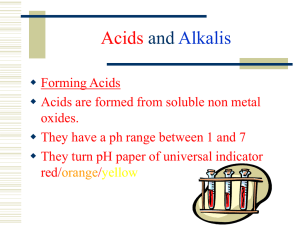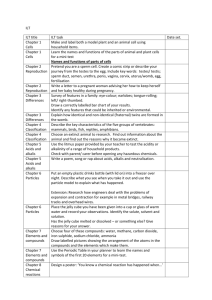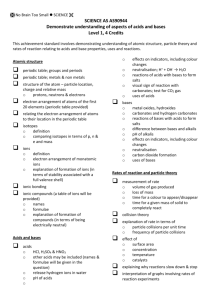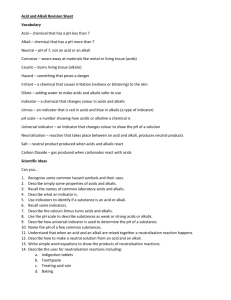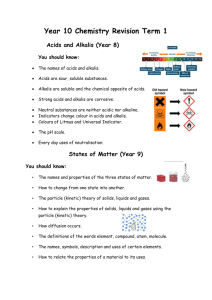C3*in a nutshell!
advertisement
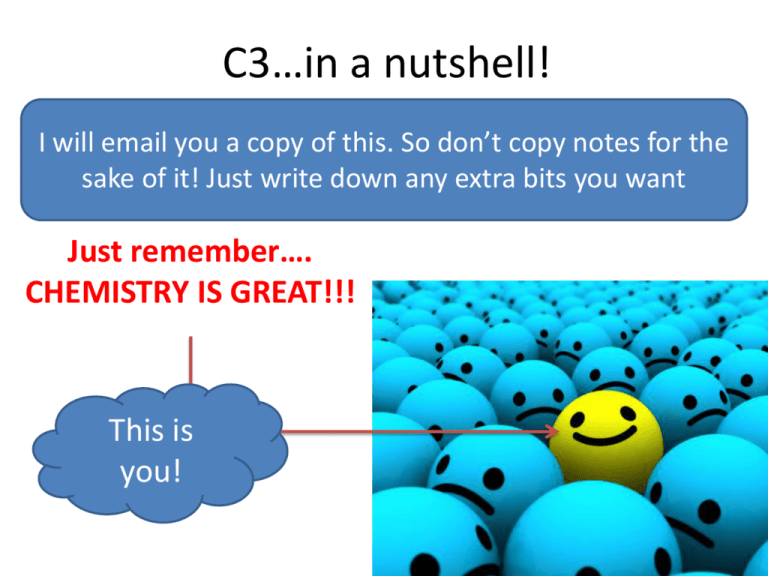
C3…in a nutshell! I will email you a copy of this. So don’t copy notes for the sake of it! Just write down any extra bits you want Just remember…. CHEMISTRY IS GREAT!!! This is you! Periodic Table Analysis Water C3 Energy Acids & Alkalis Periodic Table Early Periodic Table NEWLANDS: • Built on Dalton’s Law of Octaves ( every 8th element had similar properties) • Arranged by atomic mass • Two elements in same box MENDELEEV: • Arranged by atomic mass • Similar properties • Left gaps for elements yet to be discovered You silly man!!! Periodic Table Modern Periodic Table YUMMY!! • Metals/Non-metals • Arranged by proton number • Groups – number of electrons on outer shell • Periods – number of shells Periodic Table Group 1 – Alkali Metals • • • • • • Stored in oil, as reacts with oxygen in air Group 1 metals 1+ ion Li, Na, K – less dense than water Reaction with water --> make H2 Alkali metals….metal hydroxide Universal indicator – purple Down group – lower mpt/bpt • • • • Reactivity INCREASES down the group Larger atom Outer electron further away from +ve nucleus EASIER to lose due to SHIELDING effect of other electrons • Less electrostatic force Periodic Table • • • • • Group 7 – Halogens Group 7 non-metals 1- ion Coloured vapours Diatomic molecules Down the group – higher mpt/bpt Forms ionic compounds with Grp1 HALOGEN DISPLACEMENT A more reactive halogen will displace a less reactive one from a compound • Reactivity DECREASES down the group • Larger atom • Outer shell further away from +ve nucleus • HARDER to gain an electron due to SHIELDING effect of other electrons • Less electrostatic force to attract electron Periodic Table Transition Metals Compared with Group 1… • Higher mpt • Higher density • Stronger/harder • Much less reactive Used for catalysts Form coloured compounds Ions with diff charges • Similar properties because they fill an inner 3rd shell ( 3d shell). This can hold 18 electrons, once 2 electrons fill the 4th energy level. • Usually have same number of electrons on outer shell Periodic Table Analysis Water C3 Energy Acids & Alkalis Water • Water evaporates due to Sun’s thermal energy. • Condenses to form clouds • Precipitation ( rain/snow/sleet) occurs. Water Cycle Ionic compounds are soluble, but covalent ones are not. Water Solubility Saturated Solution maximum amount of solute that can be dissolved in a solvent at a given temperature. Heat up solvent….more solid solute will be dissolved Leave to cool….solid solute will crystallise out of solution GASES: Increase temperature….solubility DECREASES Increase pressure…solubility INCREASES Hot water from cooling towers THERMAL POLLUTION Less O2 for me! Water Hard Water Soft water easy lather Hard water less lather Contains Mg2+ and Ca2+ ions, dissolved when water passes through rocks SCUM When hard water reacts with soap. SCALE When hard water is heated. SCALE is basically limescale which is Calcium Carbonate which is a solid ppt and forms on metal appliances reducing efficiency. +ve - Ca for bones/teeth -ve - Kettles furrow up less efficient Water Removing Hard Water Use washing soda Add Sodium Carbonate Precipitates out the Ca and Mg ions to form insoluble carbonates Ion Exchange (water softener) Filled with resin. Contain Sodium/Hydrogen Ions As the water is passed through the resin, the Na/H ions are EXCHANGED with the Ca/Mg ions. Needs to be topped up with Na ions so NaCl is poured in to replenish. Water Water Treatment Made safe to drink by removing solids and micro-organisms Water source Filter solids Sedimentation of small particles using Aluminium sulphate Filter of fine sand Chlorine used to disinfect Distillation = PURE WATER Carbon reduces Cl levels Ion exchange resin Silver discourage bacterial growth on filter Periodic Table Analysis Water C3 Energy Acids & Alkalis Acids & Alkalis Strong/Weak Acids/Alkalis TESTING whether strong or weak…use Universal Indicator STRONG ACIDS fully dissociate into their ions HCl H+ + ClWEAK ACIDS partially dissociate into their ions CH3COOH ↔H+ + CH3COO- Same for alkalis, just OH- ions Acids & Alkalis NEUTRAL – pH7 Titration Used to determine accurately how much alkali is needed to react completely with a known volume of acid ( or vice-versa) END POINT Unknown volume Acid-base reaction is complete Phenolphthalein STRONG ALKALI and WEAK ACID Known volume and conc Methyl Orange STRONG ACID and WEAK Alkali Acids & Alkalis Write what you know from the question. Titration Calculations 2NaOH + H2SO4 Na2SO4 + 2H2O V = 30cm3 Conc = ? 1. Convert vol into dm3 by dividing by 1000. 2. Calculate moles of substance of known vol and conc MOLES = Vol x Conc V = 20cm3 Conc = 0.5 3. Look at the equation for the ratio. Here, it is 2:1 4. Now rearrange the formula to allow you to work out the unknown So we calculate moles of acid here and then multiply this by 2 If they want you to work out the g/mol All you do is multiply the RFM ( they give you this!) by the concentration you calculated Acids & Alkalis Arrhenius Theories Acid - produces hydrogen ions, H+ in water solution. Base - produces hydroxide ions, OH− in water solution. H+ Losing it’s electron… means it’s just a proton My ideas were rejected as they were new and I was just a student Acid – proton donor Base – proton acceptor We are well known and built upon Arrhenius ideas so our ideas were readily accepted Periodic Table Analysis Water C3 Energy Acids & Alkalis Acids Energy & Alkalis Energy from fuels Calorimeter Think HSW! 4.2J raises temp of 1 g of water by 1 degree A+BC If 0.1 mole of reactants. Total mass of A and B is 100g. Temp start is 19.6, temp max is 26.1 Work out diff….6.5 Energy change = mass x 4.2 x temp change Bomb calorimeter (Don’t need to learn this, you would get this) So for 0.1 moles = 2730J For 1 mole 2730 x 10 27300J (27.3kJ) …..exothermic reaction ( as temp rise) = -27.3kJ/mol Food high in carbs and fats have lots of energy!! more than body needs obesity Acids Energy & Alkalis Energy changes Reaction = bond breaking ( endo) and bond making ( exo) ENDOTHERMIC EXOTHERMIC Energy required to break bonds in less than energy released when new bonds are formed CATALYST…. Lowers activation energy Energy required to break bonds in greater than energy released when new bonds are formed ∆H = + ve ∆H = - ve Acids Energy & Alkalis Bond energies Identify the bonds…..stick diagrams! CH4(g) + 2O2(g) Bond Bond energy kJ/mol H-H 436 Cl-Cl 242 H-Cl 431 O-H 464 C-C 347 C-O 335 O=O 498 2H2O(l) + CO2(g) Add up on the bonds in the reactants. This is bond energy needed to break the bonds Add up on the bonds in the products. This is bond energy needed to make new bonds. REMEMBER… making new bonds is an exothermic reaction…so it is always a –ve number ∆H = bond breaking + (- bond making) Periodic Table Analysis Water C3 Energy Acids & Alkalis Acids Analysis Energy & Alkalis Positive Ions Add Sodium Hydroxide Fe 3+ FLAME TESTS metal flame test colour barium apple green calcium brick red potassium lilac lithium bright red sodium orange Fe 2+ Cu 2+ Add NaOH, gently warm. Ammonium gas turn red litmus paper blue Acids Analysis Energy & Alkalis Negative Ions Carbonates add acid bubbles if they turn limewater cloudy SULPHATES ( add HCl to removes any carbonate ions) Add Barium Chloride white ppt Halides Add nitric acid and silver nitrate Cl Br I White Cream Yellow NITRATES Copper Carbonate Copper Oxide Zinc Carbonate Copper Oxide Test for ammonia first negative result Add ALUMINIUM ( this reduces the nitrate ion to Ammonium ions) Test again for ammonia gas positive result Acids Analysis Energy & Alkalis Organic Compounds BURN or CHAR when heated Unsaturated compounds , have a double/triple bond. Test using bromine water….goes from orange to colourless COMBUSTION ANALYSIS ( empirical formula) Complete Combustion products are always water ( H20) and Carbon Dioxide (CO2) Moles = Mass / Mr ( They will give you the mass and Mr in the question) Moles Ratio CO2 H20 44g /44 18g / 18 1 mole 1 mole (x 2) 1 2 = CH2 Acids Analysis Energy & Alkalis Instrumental Analysis All due to advancements of computers Mass Spectrometer and Atomic Absorption Spectroscopy Identify elements Chromatography can separate compounds in mixtures Highly accurate, quick and enables small quantities to be tested Expensive, specialist training needed, only interpreted by comparison of known specimans Periodic Table Analysis Water C3 Energy Acids & Alkalis

